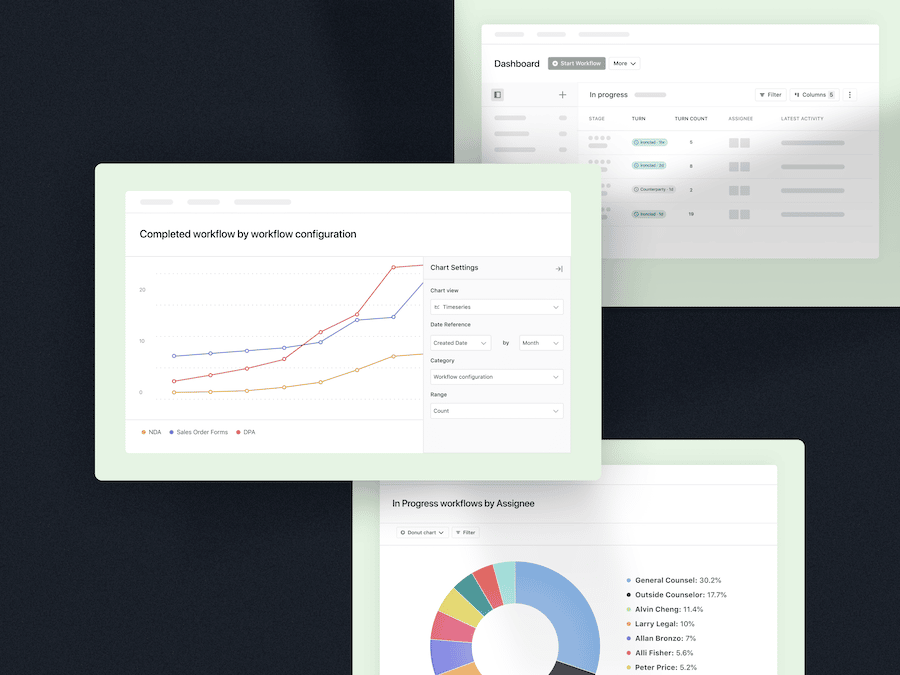In Mad Men, Don Draper is the creative mastermind behind one of Manhattan’s elite advertising firms. His approach is nothing short of magic: clients go to him with problems, he takes a few swigs of whiskey, and out comes a brand new concept, sure to make his client millions. He’s not informed by numbers or market research or last quarter’s sales data — but this was the ‘60s, a time when it was perfectly acceptable to take a suave man at his word.
Things have changed. Matters once determined by the gut are now subjected to the rigorous scrutiny of data. Today, it’s hard to find a department or industry where quantitative benchmarks, quotas and research don’t determine goals and strategy.
Corporate legal teams have been some of the last holdouts, but it’s not necessarily their fault. Without tools — such as a contract data management system — for tracking their outputs, corporate legal teams lack data that other teams take for granted. Being data-driven just hasn’t been an option.
Without data, legal teams appear to live in black boxes
Business counterparts view them as “cost centers” because, quite simply, legal teams haven’t been using data to prove their own value. Most legal teams today still can’t answer even the most basic questions about contract specifics. How many contracts need to be renewed in the next month? How many contracts are currently under review? What percentage of contracts contain a particular IP assignation?
Being unable to answer these types of questions isn’t just an inconvenience. It introduces two distinct challenges to your legal team and, ultimately, your business: first, it makes it impossible to operationalize — meaning, to implement systems, processes and metrics that enable Legal to do faster, better work with fewer resources. Second, it opens companies up to risks introduced by every contract that goes down an unsanctioned path or that contains untracked provisions or clauses.
Two categories of contracts data offer the antidote
First, there’s operational data, which helps improve legal operations and prove Legal’s business value. Second, there’s substantive data, which enables Legal to get ahead of contractual risks and obligations.
Operational data, or data related to processes, lets you define operating processes and prove value. Examples of such data include:
- Time between contract request and final signature
- Number of rounds of revision
- Turnaround time at each stage of the contracting process
- Average response time for each responsible party
- Number of workflows launched by business department
- Number of workflows completed
Substantive data lets you identify contract risks and obligations. Examples of such data include:
- Customer legal entity
- Contract amount
- Contract duration
- Governing tax law
- IP clauses
- Implementation obligations
- Data protection obligations
Legal teams need both types of information to effectively participate in the modern business. As I explained in a previous post on metrics, having access to this information allows your team to set concrete performance goals, test different approaches to contract management, and demonstrate value to company leadership.
The root cause for legal’s inability to keep up with the business is a lack of tools
Without a single system of record for all contract workflows and data, legal teams have found it practically impossible to track their inputs (e.g., contract revision requests) and outputs (e.g., contract volume). And without understanding inputs and outputs, they’ve struggled to streamline operations and keep up with the pace of business.
Centralizing contract data management doesn’t just save your team time — it helps the entire organization become more accountable, efficient, and resilient. If, for instance, you’re able to implement a new process that decreases turnaround time by 25%, you can show leadership your team’s effect on the bottom line. If a team member leaves or goes on vacation, you don’t lose key context about the contracts they worked on. And when you want to apply advanced technologies down the line — things like artificial intelligence or machine learning — your company has high-quality training data at its disposal.
In conclusion
Data has transformed industry after industry by helping people focus their efforts on what’s most important and by taking the guesswork out of decision-making.
Ironclad, our contract management software, gives legal teams a data management foundation by tracking all contract-related data points, whether that’s information on what’s in your contract, such as contract value and indemnification clauses, or information on how the contract was prepared (e.g., number of rounds of revision, internal requester, etc.), and storing it one place. Schedule an Ironclad demo today and help your team do the same.
Ironclad is not a law firm, and this post does not constitute or contain legal advice. To evaluate the accuracy, sufficiency, or reliability of the ideas and guidance reflected here, or the applicability of these materials to your business, you should consult with a licensed attorney. Use of and access to any of the resources contained within Ironclad’s site do not create an attorney-client relationship between the user and Ironclad.




